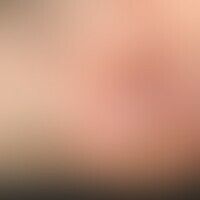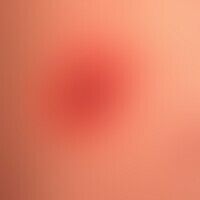
Klippel-trénaunay syndrome Q87.2
Klippel-Trénaunay syndrome. Extensive nevus flammeus; so far no evidence of soft tissue hypertrophy. No pelvic obliquity!

Acrodermatitis chronica atrophicans L90.4
Acrodermatitis chronica atrophicans. 78-year-old female patient with confirmed neuroborreliosis 6 years ago and still positive Borrelia serology. Multiple, chronically inpatient, persisting for 2 years, asymmetrical (only on the left leg), blurred, sometimes burning pain, large, red to red-livid, smooth erythema, partly with crinkled surface (cigarette-paper-like puckering).

Necrobiosis lipoidica L92.1
Necrobiosis lipoidica: bilateral, gradually increasing, moderately sharply defined, confluent, reddish-brownish, centrally slightly atrophic plaques that have existed for about several years.

Gout M10.0
Arthritis urica: sudden spontaneous and painful (difficult to walk) redness and swelling (circled in black) of the right metatarsophalangeal joint of the big toe.

Vasculitis leukocytoclastic (non-iga-associated) D69.0; M31.0
Vasculitis leukocytoclastic (non-IgA-associated): multiple, since about 1 week existing, localized on both lower legs, irregularly distributed, 0.1-0.2 cm large, confluent in places, symptomless, red, smooth spots (not compressible).

Ecchymosis syndrome, painful R23.8
Ecchymosis syndrome, painful seti 6 months of recurrent, painful, extensive skin bleeding on the abodes and extremities in an otherwise healthy 69-year-old female patient

Melanoma amelanotic C43.L
melanoma malignes amelanotic: since early childhood a pigment mark is known at this site. continuous growth for several years. for half a year extensive ulceration of the node. no significant symptoms.

Insect bites (overview) T14.0

Artifacts L98.1

Erythema migrans A69.2
erythema chronicum migrans. shown here is a finding about 3 months old. approx. 10 days after (rememberable) puncture, a painless, non-itching circular erythema developed, only moderately well distinguishable from normal skin. 3 months later the doctor was consulted.

Erysipelas A46
Erysipelas. hemorrhagic blistering and erosions on sharply defined erythema in the area of the foot.













